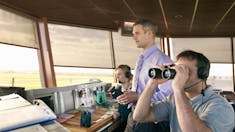Train Driver Tests: Putting Yourself in the Driving Seat (2025 Guide)
All products and services featured are independently selected by WikiJob. When you register or purchase through links on this page, we may earn a commission.
- What Are Train Driver Psychometric Tests?
- How Long Does It Take to Qualify As A Train Driver?
- What Skills and Competencies Are Tested on the Train Driver Test?
- What Is the Format of the Train Driver Assessment?
- What Types of Psychometric Tests Are Necessary to Become a Train Driver in 2025?
empty
empty
empty
empty
empty
empty
empty
empty
empty
empty
- Format for Train Driver's Interview
empty
empty
empty
empty
- Train Driver Selection Process Tips
- Leading Train Companies in UK & Europe
- Train Driver Application Process
- How Do I Prepare for and Pass a Psychometric Train Driver Assessment in 2025?
- Frequently Asked Questions
- Final Thoughts
If you are planning a career as a train driver, one vital thing to know is that there is a very rigorous trainee recruitment process.
Train operating companies know exactly the type of candidate they are looking for. They assess the suitability of prospective drivers through a series of complex train driver aptitude tests.
Train drivers need to have vital cognitive and psychomotor skills to perform the job safely, so you can expect the tests to assess these capabilities.
What Are Train Driver Psychometric Tests?
Train driver psychometric tests are a suite of assessments that determine your suitability for the job.
The pack of tests evaluates key attributes such as attention span, perception, hand-eye coordination, and alertness and reaction time.
The exact format of train driver tests depends on where you are in the world, as companies work to different standards mandated by global railway authorities.
As a train driver, you will be responsible for safely transporting passengers or freight in varying conditions.
Alongside a safety test, you can expect the train driver's psychometric assessments to cover logical, verbal, numerical and mechanical reasoning.
The assessments measure your inherent skills through timed tests that require both accuracy and speed, two things it can be difficult to achieve at the same time.
For this reason, preparation is really important.
If you complete plenty of practice tests under timed conditions, you can heighten your senses and strengthen the skills you already have.
Replicating the test environment will help you feel ready to take on the real thing.
How Long Does It Take to Qualify As A Train Driver?
The duration to qualify as a train driver can vary depending on the specific requirements and training programs in different countries or regions.
Typically, the process involves several stages of training, assessments and practical experience.
What Skills and Competencies Are Tested on the Train Driver Test?
The assessments are held at train driver psychometric test centers and are likely to differ from any exam you have taken at school or university.
The psychometric test train driver is not so much about revising knowledge to remember at the crucial moment. Instead, they will assess your natural capabilities.
Some of the concepts the test will measure include:
- Concentration
- Observational skills
- Memory recall
- Reactions
- Vigilance
- Cognitive processing
What Is the Format of the Train Driver Assessment?
The format of a train driver assessment can vary depending on the specific railway company or organization conducting the assessment.
However, train driver assessments generally include several components designed to evaluate the candidate's suitability for the role.
Here are some common elements that may be included:
- Application
- Psychometric Tests
- Aptitude Testing
- Driver Simulation
- Medical Assessment
- Interview
- Background Checks
Practice Train Driver Tests with JobTestPrep
What Types of Psychometric Tests Are Necessary to Become a Train Driver in 2025?
Different countries have different requirements to become a train driver, including age restrictions and train driver psychometric test cost.
In the UK and US, you need to be 21. In Australia, the minimum age is 18.
For candidates in the UK, a series of psychometric tests await you if your written application is successful.
In the UK, tests such as the southeastern train driver assessment cost around £120.
In Australia, you will be required to take a three-week safe working course.
This usually costs around $2,200.
For the US, the cost can reach the thousands as there is the option to take a conductor or engineer training program.
Colleges in California, Dakota and Kansas are popular choices for these courses.
If you want to become a train driver in the US, a high school diploma or equivalent qualification is a common requirement.
Drivers are educated in-house by their rail company employer, with the training programs combining classroom teaching and hands-on experience.
Operating a passenger or freight train means taking a test for a federal license after completing a formal engineer program.
Trainee drivers are also required to pass tests assessing their skills, hearing and vision, and their knowledge of the railroads.
To become a train driver in Australia, you will need to take a work safety test alongside assessments of logical reasoning, verbal reasoning, numerical reasoning and mechanical reasoning.
The major psychometric tests for train drivers across the world are:
Group Bourdon Test
The Group Bourdon test is also known as the dots test, as it involves identifying boxes that contain four dots and ignoring all other boxes containing three, five or six dots.
The test can be taken either with pen and paper or on a computer.
With five pages each containing 25 columns, and two minutes allowed for each page, this test requires 10 minutes of perfect concentration.
This test is regarded as the hardest part of the psychometric testing process, mainly because candidates do not know what to expect.
The Group Bourdon test is designed to assess your ability to concentrate while performing tasks at high speed.
With some prior research and practice, you can familiarize yourself with how the test works, which will save any last-minute surprises.
Pro Tip 1
At first glance, the GBT may seem deceptively simple. However, the visual impact of a large page full of similar-looking boxes and nearly identical patterns can easily play tricks on the eye.
With just two minutes per page, you must get the maximum number of correct picks the first time. There is no second chance to revisit and revise the answers.
Pro Tip 2
It is impossible to finish all of the rows on a page.
If you take just half a second to scan one box in a row, checking a single row of 25 boxes and marking out the four-dot boxes will take you around 15 seconds.
The allocated time for each page is two minutes (120 seconds).
Try not to worry about finishing all of the rows. Even if you can get through seven or eight rows, your aim is to accurately identify the correct number of boxes with four-dot patterns in all of these rows.
This is a much better approach than trying to check through ten rows and getting the numbers wrong on six of them.
Pro Tip 3
Putting in plenty of practice will help your brain to scan an entire row much faster.
You will be able to visualize the patterns in one glance, which means you will be able to highlight the intended four-dot boxes in a row more quickly.
After you spend a while practicing, you will notice that the four-row boxes seem to stand out from the others.
To reach this stage, you will need to increase your focus and be prepared to shut the world out, concentrating solely on the task at hand for a solid ten minutes.
Test of Everyday Attention (TEA-OCC)
This occupational assessment tests how well you can concentrate, follow instructions and multitask. It is split into three stages, with each one getting progressively harder.
The test is broken up in three stages:
Part 1: Attention to Auditory Alerts
In the attention to auditory alerts section of the test, focus on counting low tones in a series of high and low tones. The auditory alert component requires heightened concentration, so create a distraction-free mental environment for optimal performance. The simple instruction—'count the low tones'—is deliberate, streamlining cognitive efforts.
Consider this as a precision-focused mental exercise testing auditory processing and attention span. Success hinges on cultivating a space for attentive listening, leading to accurate counting.
Practice under test conditions enhances auditory alertness and efficiency in counting low tones within time constraints.
Part 2: Directory Search
In the directory search section of the assessment, you'll quickly navigate a grid to identify and mark boxes matching a given combination.
The time constraint demands a precise cognitive response, relying on your ability to pick up cues and swiftly pinpoint the correct answers. Adopting a systematic scanning technique, such as moving from left to right, enhances efficiency and accuracy. Meticulous preparation, including simulating test conditions, sharpens your ability to process information swiftly.
Furthermore, regular practice improves speed, focus, and accuracy, ensuring readiness for the time-sensitive directory search task in the actual assessment.
Part 3: Combination of Both Part 1 & 2
The cominbation part of the occupational assessment test combines auditory alert tasks with grid searching, testing your accuracy, speed, and multitasking ability.
You'll count beeps following provided instructions and simultaneously perform a grid search, similar to Part 2. Practice is crucial for success in this section of train driver assessments.
In addition, pay careful attention to instructions; some scenarios involve identifying low tones among mixed beeps, while others feature a single pitch.
If you need to prepare for a number of different employment tests and want to outsmart the competition, choose a Premium Membership from JobTestPrep.
You will get access to three PrepPacks of your choice, from a database that covers all the major test providers and employers and tailored profession packs.

Trainability for Rules and Procedures Test (TRP)
The two-part TRP test evaluates three things: understanding, retention and understanding of new information.
Part 1
This part of the test is designed to assess how well you can understand and retain new information.
First, you will need to listen to a train-related audio clip and make mental notes.
When the clip finishes, you will be given an information sheet about the topic.
You will be able to jot some notes on the sheet as you read through the passage. This is recommended as it is scientifically proven to aid in retention.
After around five minutes, the instructors will take away the sheet, and you will be given a set of 15–20 multiple-choice questions about the topic.
Ensure you listen attentively to make it easier to recall the information.
Part 2
This part of the test is also known as the cable and dials test. It assesses your ability to interpret visual information and prioritize dealing with possible defect scenarios in a real-world setup, something you will need to do as a professional train driver.
The group of around 40 multiple-choice questions will present different variations of sets of dial readings.
You will be required to check the relative priority for each of the colored dials before identifying the correct sequence in order of priority from highest to lowest.
As with many of the train driver tests, this exercise is timed.
Virgil Test
This is a different version of the vigilance test. Its purpose is to check your ability to stay alert and responsive to critical events while monitoring seemingly monotonous tasks.
Instead of a flashing grey square, you will see a bright dot moving across a circular path.
Other test versions exist, but this version is the most common.
The dot flashes and moves around in small jumps, following pre-set stepping stones.
As soon as you see a flashing dot, take a double jump. You will need to react and register your response by pressing the green button.
Some test variations do not show the circular path jotted down on the screen to increase the difficulty level.
Whichever version of the test you take, the end purpose is the same – to check against fatigue and decrease efficiency over prolonged intervals.
2 Hand Coordination Test
As the name suggests, this test assesses coordination between both hand movements. It also considers hand-to-eye synchronization.
The 2Hand Two Hand Coordination Test is administered using a custom computer terminal with a knob or joystick. On the screen, you will see a virtual track and ball.
You will need to use the knob or joystick to regulate the motion of the ball, ensuring it travels through the winding trajectory shown on the monitor without skidding off the track.
The critical parameters tracked during this test are total mean duration and total mean error duration.
Stay relaxed during the test, as tension will make it more difficult.
Adaptive Tachitoscopic Traffic Perception Test (ATAVT)
This psychometric test is administered through a computer and assesses your visual perception and information capturing skills.
You will be exposed to a very brief stimulus, usually a flash of a scene from a road.
The picture will stay on screen for no more than a second, and you will be presented with multiple-choice questions on major items that may or may not have been in the picture, such as buses, cars, traffic lights and pedestrians.
The more you can practice glancing at a brief visual and answering questions about it, the better prepared you will be for this test.
WAFV Vigilance Test
This train driver psychometric assessment is all about testing your vigilance, keeping a watch for possible danger or difficulty. So, this is something you will need to excel in as a train driver.
The test measures how long your attention span lasts and how alert you remain to externally applied stimuli.
As part of the test, you will be shown a flashing grey square on your screen that will change color.
As soon as you notice a change in color, press a green button to register it.
This test lasts for around 30 minutes, so it is important to maintain your concentration.
Situational Judgement Exercise (SJE)
Alongside psychometric tests that analyze your inherent abilities, you may also be required to take a train driver situational judgment test.
This kind of test is rooted in behavioral science and helps assessors understand how you might react to a given situation.
In most of the SJE test cases, the focus for you is to understand professionalism, attitude and awareness of safety procedures.
Presented with a scenario and multiple options, you will need to mark the options from most to least favorable responses.
The options usually range from 'Very Helpful' to 'Very Unhelpful'.
This test can be difficult as, strictly speaking, there is no right or wrong answer.
The thing to remember is that there are answers more favorable than others, and these are what the test is asking you to choose.
Weigh up all of the options and apply common sense and a safety-first mindset to identify the best course of action.
Written Communication Test
After so many mandatory evaluations, you will be pleased to know that the written communication test is often an optional part of the assessment suite.
It has no pass/fail impact on your overall result. However, still, some train operating companies insist on including it in the train driver psychometric assessment process.
As a train driver, you won't need extensive literature knowledge or advanced writing talents, so this test is more about ensuring you can express yourself clearly and legibly.
These are skills that will be required if you need to write a situation report while on the job.
Usually, this test will include you being asked to prepare a small write-up about a stated topic.
The important things to remember here are to keep your writing simple and legible and in line with basic grammar and sentence structure.
Other Administered Tests on the Train Driver Exam
In addition to the tests listed above, some TOCs include further tests on logical reasoning and numerical reasoning.
If you have been asked to sit the train driver exam, it is always best to ask the TOC to confirm the suite of tests you will be expected to complete.
You might also see different versions of the tests outlined above.
For example, the Rules Acquisition Aptitude Test (RAAT) is a variation of the TRP test with the audio section removed.
The Safe Concentration and Attention Test (SCAAT) test is an alternative version of the tests used to assess concentration and attention.
Format for Train Driver's Interview
The format of a train driver's interview can vary depending on the specific train company and their selection process.
However, typically, the interview will consist of a combination of behavioral, situational and technical questions to assess your suitability for the role. Here are some common components you may encounter:
Behavioral Questions
These questions aim to assess your past experiences, behaviors, and competencies.
You may be asked about your teamwork skills, problem-solving abilities, communication skills, decision-making and handling difficult situations.
Situational Questions
These questions present hypothetical scenarios that you may encounter as a train driver.
You will be asked how you would respond or handle specific situations to gauge your ability to make sound judgments, prioritize safety and handle emergencies.
Technical Questions
These questions test your knowledge of train operations, safety procedures, and regulations. You may be asked about signaling systems, route knowledge, understanding train controls, speed limits, and adherence to operating rules.
Competency-based Assessment
The interviewers may assess specific competencies relevant to the role, such as attention to detail, stress management, customer service and adherence to safety protocols.
Train Driver Selection Process Tips
- Familiarize yourself with the train company you are applying to, including their values, safety culture, and operational practices. This will demonstrate your genuine interest and preparedness.
- Gain a comprehensive understanding of the responsibilities, challenges, and requirements of a train driver. This will help you align your answers with the specific expectations of the role.
- Think of specific examples from your past experiences that demonstrate your relevant skills and competencies. Use the STAR method (Situation, Task, Action, Result) to structure your answers effectively.
- Safety is paramount in the train industry. Emphasize your commitment to safety, your ability to follow procedures, and your attention to detail when discussing your suitability for the role.
- Train drivers often interact with passengers. Highlight your customer service skills, ability to handle difficult situations calmly, and commitment to providing a positive experience for passengers.
Leading Train Companies in UK & Europe
| Train Company | Country |
|---|---|
| National Rail | United Kingdom |
| Eurostar | United Kingdom/France/Belgium |
| Virgin Trains | United Kingdom |
| Deutsche Bahn | Germany |
| SNCF | France |
| Trenitalia | Italy |
| Renfe | Spain |
| ÖBB (Austrian Federal Railways) | Austria |
| SBB (Swiss Federal Railways) | Switzerland |
Train Driver Application Process
The train driver application process can vary depending on the train company. However, it typically involves the following steps:
- Start by submitting an online application, which includes providing your personal details, work experience, qualifications and answering specific questions related to the role.
- If your application is successful, you may be invited to complete train driver aptitude test, which can include assessments of numerical reasoning, mechanical comprehension and sometimes abstract reasoning or situational judgment tests.
- Some train companies may conduct an assessment center, which may involve further tests, group exercises, role-plays, interviews and simulations to assess your suitability for the role.
- Train driving requires meeting certain medical standards to ensure fitness for the role. You will undergo a medical examination.
How Do I Prepare for and Pass a Psychometric Train Driver Assessment in 2025?
While the exact psychometric tests for train drivers you will take may depend on where in the world you are, the importance of preparation transcends borders.
Remember that each railway psychometric test is there to measure your skills and not to catch you out.
Follow our study tips, and you will have the best chance of succeeding and moving one step closer to your dream job:
Step 1. Prepare Properly
Study any preparation materials you are given by your train operating company or seek out official practice materials.
Knowing what is ahead will calm your nerves and help you feel prepared.
Step 2. Know What to Expect
Make sure you know what to expect from each section of questions.
Step 3. Practice Group Bourdon Tests
As described earlier, the group bourdon tests are a common stumbling point because they are not intuitive. This is an especially important test to practice in advance.
Step 4. Take Mock Tests at Home
Try to recreate a mock assessment at home and do all the sections and test elements in one sitting or in the timings you would use for the official test.
With speed and accuracy being so important in the suite of assessments, practicing similar questions will improve your pace
Step 5. Take Breaks
Make sure you take study breaks! Yes, practice is really important, but burning yourself out is not the goal here.
Taking time away from revision will help consolidate what you have learned.
Just before your train driver psychometric assessment, be sure to give your mind a break and get plenty of rest so you can feel refreshed for the big day.
Practice Train Driver Tests with JobTestPrep
The train driver test refers to a suite of assessments used in the hiring process for train drivers.
In addition, the tests are designed to assess a candidate’s psychomotor and cognitive skills to establish whether they are a good match for the role of a train driver.
The exact tests you will take vary between TOCs.
The train driver test refers to a set of assessments used in the selection process for train drivers.
Candidates do not require any specific knowledge to pass the tests. However, they must demonstrate the required level of mental agility and cognitive skills.
All of the tests are conducted under strict time constraints, which adds an extra element of difficulty.
Yes, all of the tests in the train driver test suite are timed. You must work against the clock, demonstrating that you can work quickly and accurately under pressure.
The most common tests included in the train driver tests are:
- The Train Driver Mechanical Reasoning Test
- Trainability for Rules and Procedures Test (TRP)
- Group Bourdon Test
- Test of Everyday Attention (TEA-OCC)
- Traffic Perception Test (ATAVT)
- Vigilance Tests
- Train Driver Situational Judgment Test
- Written Communication Test
Apart from this, you may be asked to take numerical reasoning, verbal reasoning and logical reasoning tests and participate in assessed group exercises.
Final Thoughts
The process of landing your dream job might sound scary and unattainable.
It is true that the train driver psychometric test is not easy, but you already have many of the abilities and competencies that will help you succeed.
Now you know how the tests are structured and what assessors are looking for, you can fill in any gaps in your skill set.
The most important thing to remember is that practice makes perfect.
Train drivers need to have a steady and considered manner, so try to embody this chilled mindset and don't sweat the small stuff!





